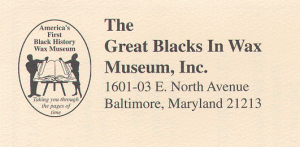 Each wax figure, clad in appropriate historical attire, is part of a scenic display depicting the struggles, achievements and contributions of African peoples worldwide. Each display is presented chronologically, highlighting ancient Africa, the Middle Passage, the Antebellum and Postbellum periods, Reconstruction, the Harlem Renaissance, and Civil Rights era, and the present. |
The personalities from each period are those whose lives exemplify the African American traditions of help, uplift, and protest. They are those of humble beginnings who have risen through great sacrifice and against tremendous odds to achieve distinguished recognition or make outstanding contributions to American and world civilization. They are also whose who pioneered or excelled in particular fields of endeavor. But above all, they are those whose talents and genius reflect the talent and genius of the African-American masses.
Great Blacks in Wax not only views African-Americans from the past, but also sees history as an involvement of the past, present and future. Thus, the museum gives African-Americans a sense of continuity, precedence, and foundation so that they can know the direction in which they are or should be heading. However, in carrying out this aim, Great Blacks in Wax remains a non-partisan educational and cultural center which does not advance any particular political, racial, economic, or religious ideology but acknowledges the contributions of those of diverse backgrounds.
This unique museum, the first one of wax in Baltimore, Maryland and the first wax museum of African-American history in the nation, is the brainchild of Drs. Elmer and Joanne Martin. They established the museum in 1983 with several objectives in mind; one, to stimulate an interest in African-American history by revealing the little-know, often neglected facts of history; two, to use great leaders as role models to motivate youth to achieve; three, to improve race relations by dispelling myths of racial inferiority; and four, to support and work in conjunction with other non-profit, charitable organizations seeking to improve the social and economic status of African-Americans. The museum had begun to carry out these objectives during its two years on Saratoga Street where it received nearly 2,000 students from city and county schools during African-American history month of 1984 and about 2,500 during that month in 1985, as well as visitors and tour groups from Delaware, New York, New Jersey, Virginia, Pennsylvania, and Washington, D.C. – all as a result of local and national media exposure.
The Martins soon realized, however, that Great Blacks in Wax, finding it difficult to accommodate large groups, had begun to outgrow the 1,200 square foot facility. Therefore, they initiated a search for a larger building and for funds to develop a new museum. In 1985, State Senator Clarence Blount sponsored a bill awarding the museum a $100,000 matching grant. The same year the Martins closed the Saratoga Street Facility and, with the help of their newly-formed Board of Trustees, launched a fund-raising campaign to match the grant. Between 1985 and 1987, the City of Baltimore awarded Great Blacks in Wax $300,000 in grants and loans and designated an unused fire station at 1601 East North Avenue for the museum’s development and expansion.
The renovated firehouse, a Victorian Mansion, and two former apartment dwellings provide nearly 30,000 square feet of exhibit and office space. Over 100 wax figures and scenes, a full model slave ship exhibit telling the powerful 400 year history of the Atlantic Slave Trade, a compelling exhibit on the role of youth in making history, a Maryland Room highlighting the contributions of outstanding Marylanders to African-American history, a gift shop, and a mini auditorium for lectures, films, and dramatic presentations are some of the major cultural features of the museum.
For the most part, Great Black In Wax serves the entire nation, particularly Baltimore, Washington, D.C., Virginia, Pennsylvania, Delaware, New York, New Jersey, and North Carolina. The Museum also serves visitors form other states throughout the United States. International visitors have hailed from such countries as Canada, France, Africa, England, Japan, and Israel. The Great Black In Wax story has be heralded by news media around the world. These include CNN, The Wall Street Journal, The Washington Post, The New York Times, The Chicago Sun Times, The Dallas Morning News, Kulturwelt, USA/Africa, The Los Angeles Times, USA Today, Crisis, Essence Magazine and Ebony Magazine.
The attempt to institutionalize African-American history is not new. Indeed, the thrust began in the 1920’s with Carter G. Woodsman – his Journal of Negro History, his Association for the Study of Negro Life and History, and the initiation of Negro History Week. Subsequently, the Museum’s uniqueness lies not in teaching, promoting or preserving African history, but in the mechanism through which it celebrates that history. The presentation of life-like wax figures is sure to leave a lasting impression on the minds of those who experience The Great Blacks in Wax Museum.
1601-03 E. North Avenue
Baltimore, Maryland 21213-1409
Museum:(410) 563-6416
Fax:(410) 675-5040
